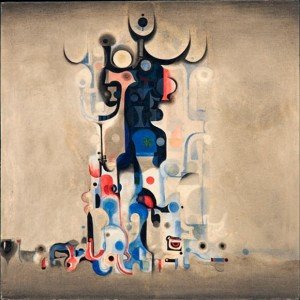The last twenty years in visual culture studies have seen a divergence from the hegemonic view that had dominated the academy for centuries, the assumption that what we define as “civilization” evolved only along the trajectory of: Egypt->Greece->Rome->Medieval Europe->Anglo-Britain->America. We know now that there have been multiple civilizations across the globe. We are now coming to realize there have also been in the 20th century multiple modernisms.
Art History departments, textbooks and museum exhibits are now reflecting histories, examples and works from these global, modern movements. No longer is non-Western art a kind of monolith or Other, relegated only to the pre-Colonial and the Ancient. Modernism has occurred vigorously and authentically in varying junctures in South, East and Southeast Asia, Africa, the Middle East and Latin America.
Vision of the Tomb (1965), by Ibrahim el-Salahi PR
From the continent of Africa, the cradle of humanity and large enough to contain the countries of China, US, Europe and India, we are now seeing recognition paid to burgeoning scientists, engineers, artists and other cultural leaders. While European modernism was ‘revolutionary’ for involving visual concepts from the non-Western world, the convention had long been to embrace, celebrate and condone these acts of intellectual appropriation….while similar efforts by the non-Western artists were derided and dismissed as imitation. The academy is gradually shifting, partly in response to global currents in the art market that have taken the art centers away from Paris, London and New York, but the road toward changing discourse and practice is ongoing.
During the 1950’s Sudanese artist Ibrahim El-Salahi pioneered, like other non-Western artists for their countries, a new visual vocabulary by fusing and re-interpreting Islamic, African, Arab and Western aesthetics. Having returned to Sudan from London in 1957, and rising to become undersecretary for culture, he traveled to Nigeria to meet writers Chinua Achebe and Wole Soyinka (who have a contentious view on the topic of African modernism) as well as the modern artists from Senegal, Uche Okeke and Demas Nwoko. The 1960’s in Africa saw a kind of a renaissance in Africa, although the 1970’s found El-Salahi imprisoned without charge during the Nimeiri regime. Later released in 1977 he moved to Qatar to serve as a cultural minister, emigrating later to England. He currently finds himself working to promote the growth and acceptance of modernism within African nations while he enjoys recognition and success in the West.
A Beninese artist who followed in El-Salahi’s footsteps is the artist Meschac Gaba who pragmatically realized how the common people were not going to museums or understood contemporary art, so he took his work as performances to the markets and the streets. Within the gallery space his installation works are comments on economics, culture and the ways in which life and art blur.
The road to recognition of modernism in non-Western countries has been tumultous. Understanding the push-back against modernisms around the globe has always been political as well as cultural. Whether this is internal among civic governments, cultural ministers or between larger, cultural regions and established academies, to study emerging visual culture is to have a finger on a people’s unconscious pulse, something that cannot be easily controlled. It is what it means to be avant-garde, and why art can be revolutionary. It is also why it is so critically important to humanity. As Theodore Roethke once wrote “Art is our defense against hysteria and death.”

